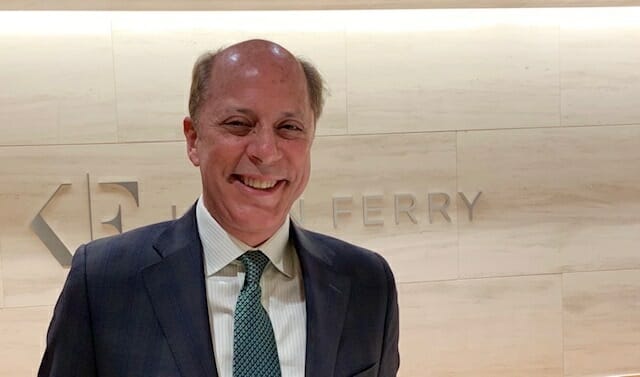If anyone knows how to make a compelling business case for diversity and inclusion (D&I) strategies, covering all industries and geographies, it’s Andrés Tapia.
He is a leading exponent in shaping a global approach to D&I that is embedded throughout companies’ leadership and talent supply chains, to the benefit of their organisations.
D&I strategist
Andrés is Senior Client Partner, global diversity and inclusion strategist and thought leader at Korn Ferry, a worldwide organisational consultancy. He’s also the author of The Inclusion Paradox, which charts his consulting work helping clients evolve to what he refers to as next-generation D&I.
After moving to the US from his native Lima, Peru, to study journalism, Andres started his career writing for a magazine before moving into corporate communications. That evolved into training, learning and development and organisational development. He worked for several consulting firms, including Accenture and Hewitt.
As co-founder of the Latino Affinity Group and Employee Resource Group, this extra-curricular D&I activities were among the reasons, he was asked to take on the role as Hewitt’s first-ever chief diversity officer. While the intent was for him to help the organisation become more diverse and inclusive, his strategic approach led him to introduce D&I to Hewitt’s consulting practices as a service offering that he also ended up leading.
Then, after three years as president of the think tank Diversity Best Practices, Andrés was head-hunted by Korn Ferry to join the D&I consulting team to work with corporations on surfacing the root causes for why they were not as diverse and inclusive as they aspired to be and then shape the strategies to break the impasse and accelerate the change.
He explains: “We seek to discover the needs across a holistic spectrum: what sort of capabilities do managers and employees need, how ready is the organisation for the required change, how effective are their diverse talent sourcing and hiring, why are women and members of other underrepresented groups stuck in being able to advance further, how to embed D&I into your talent systems and your marketing and marketplace growth?
I also work directly with CEOs and their executive teams on their own inclusive leadership. So, we do the meta diagnostic and then the individual micro diagnostic of their inclusive leadership and bring those together as we partner with executive teams on developing the strategy for moving forward.
“And, at Korn Ferry, I partner with many of my colleagues ensuring that we’re embedding D&I into every aspect of the leadership and talent supply chain. It’s not just D&I programmes and strategies, but how you address unconscious bias in high potential identification or succession management, or leadership development, or engagement.”
>See also: Shedding D&I’s ‘made in the USA’ label
D&I five-stage model
A cornerstone of Korn Ferry’s D&I offering to clients is a five-stage maturity model: compliance, awareness, integration into the talent system, integration into operations, and integration into the marketplace.
“A lot of the UK companies are either at stage one – compliant, they have a quota – and some of them are starting to move into the second stage where they’re not doing it just because they have to,” Andrés believes. “They’re realising, ‘Oh, my gosh, having women is a good thing.’”
He argues that, after the compliance stage, companies need to move to the second stage of awareness quickly. Why? “Because compliance is not that compelling,” he says. “It’s like, OK, we’ve got to do it but let’s change the conversation to how are we going to benefit because we’re going to have talent that we never had before. Making that transition is to really equip your leaders, managers and employees with the messages.”
This means avoiding using technical compliance language – leave that to the lawyers. Instead, focus on the excitement of a diverse world and the talent available within it. Companies should, “customise the business case from both a talent and business perspective” then support it with training and best practices.
Andrés points out that the awareness side is scaffolding. So, to sustain D&I companies need to address unconscious bias in their recruiting, high potential identification and succession management processes.
He explains: “For example, paying attention to the requirements; they might be very male-biased in terms of how to describe a leader. So how best to change the requirements in contemporary ways as to strip out the legacy male bias in the expectations that you have? You must embed it into your language, process and requirements and equip your recruiters and HR people. And these HR professionals should be targets of the change and not just agents of the change or passive bystanders. So, embedding D&I into the DNA of your talent process system is stage three.”
The fourth stage involves operations. “Mergers and acquisitions, globalisation, regionalisation; putting your call centre in Prague but your front office customer service in London,” says Andrés. “There are cultural issues and diversity issues in the handoff and cultural differences that get in the way of a seamless customer experience. It makes sense operationally to distribute your costs that way, but you pay attention to D&I issues to make sure that there’s a seamless customer experience due to inclusive and crossculturally agile operations.”
Stage five is integrating D&I practices into the market place. This means innovating new products and services to meet the needs of new emerging demographic groups that may have been overlooked previously and providing marketing that is cross-culturally agile and competent.
Blind resumes
Some of Korn Ferry’s clients are experimenting with using blind resumes, where a person’s name or anything that can identify them by gender or ethnicity is removed. Andrés cites studies by CNN and others which showed that people with white Anglo-Saxon Protestant names were 50% more likely to get a call back from recruiters than someone considered ‘foreign’ due to their name despite having identical skills and experience.
There’s also a move to do away with resumes altogether. This is because women candidates and those from ethnic backgrounds may not have the experiences that are traditionally required.
“Take out the name but there’s still something that the recruiter is always looking for, a particular degree or five years’ experience doing, for example, data analytics,” says Andrés. “And, because how women or ethnic minorities may be tracked in school and work into dead-end jobs, they never get it and they never will. So, the resume chronology could still be a barrier.
“There’s a tech organisation which asks clients what skills they require and then creates an ability test. They put the job on the website and then when people ‘apply’, they don’t send their resume. Instead, they are given a number and take the test. Then the top scorers of the test are asked to submit their resume and the tech company shows the client the test results demonstrating the candidates’ skills before showing the resumes.”
Given documented history of discrimination as evidenced in the CNN study, ethnic minority employees often have been unwilling to take part in surveys or put their names on forms. Andrés advises that companies should create a safe environment for people to self-identify to bolster D&I and understand the needs of different demographic groups.
Problem first, best practice later
Andrés points out that companies often make the mistake of adopting the best practice that seems exciting and creative before knowing what problem they’re trying to solve.
“Diversity can be about a thousand things but, like any business issue, you can’t address all of them all at once,” Andrés adds.
“You need to understand that your challenges around women, for example, or people in racial/ethnic minority groups in your organisation, could be different from your competitors and your stage in the maturity model. So where are you in the maturity model, what are your priorities and your readiness for the organisation to deal with it?”
Korn Ferry is more and more carrying out a D&I diagnostic with clients which then provides a road map for the next three to five years that is focused. A second priority, in order to take D&I to the next level, is encouraging a new generation of chief diversity officer. Korn Ferry published a paper on this which, in a nutshell, suggests that the chief diversity officers need to “shift from being problem-solving activists to team players who can work behind the scenes to alter how businesses operate.”
>See also: Women C-Suite ranks nudge up—a tad









